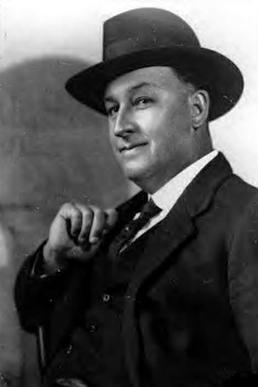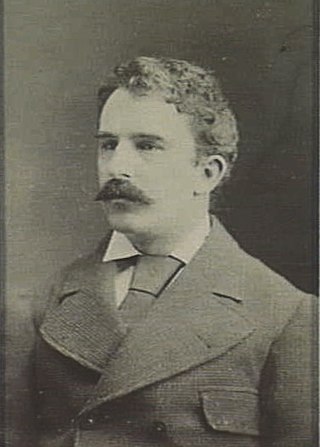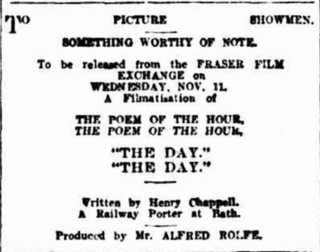Related Research Articles

For the Term of His Natural Life is a story written by Marcus Clarke and published in The Australian Journal between 1870 and 1872. It was published as a novel in 1874 and is the best known novelisation of life as a convict in early Australian history. At times relying on seemingly implausible coincidences, the story follows the fortunes of Rufus Dawes, a young man transported for a murder that he did not commit. The book clearly conveys the harsh and inhumane treatment meted out to the convicts, some of whom were transported for relatively minor crimes, and graphically describes the conditions the convicts experienced. The novel was based on research by the author as well as a visit to the penal settlement of Port Arthur, Tasmania.

Lottie Lyell was an Australian actress, screenwriter, editor and filmmaker. She is regarded as Australia's first film star, and also contributed to the local industry during the silent era through her collaborations with director and writer Raymond Longford.
For the Term of His Natural Life is a 1927 Australian film based on the 1874 novel by Marcus Clarke, directed, produced and co-written by Norman Dawn. It was the most expensive Australian silent film ever made and remains one of the most famous Australian films of the silent era.

Raymond Longford was a prolific Australian film director, writer, producer, and actor during the silent era. Longford was a major director of the silent film era of the Australian cinema. He formed a production team with Lottie Lyell. His contributions to Australian cinema with his ongoing collaborations with Lyell, including The Sentimental Bloke (1919) and The Blue Mountains Mystery (1921), prompted the Australian Film Institute's AFI Raymond Longford Award, inaugurated in 1968, to be named in his honour.

Alfred Dampier was an English-born actor-manager and playwright, active in Australia.

The Romantic Story of Margaret Catchpole, generally referred to as Margaret Catchpole, is a 1911 Australian silent film directed by Raymond Longford and starring Lottie Lyell. It is based on the true story of Margaret Catchpole, an adventurer and convict.

Alfred Rolfe, real name Alfred Roker, was an Australian stage and film director and actor, best known for being the son-in-law of the celebrated actor-manager Alfred Dampier, with whom he appeared frequently on stage, and for his prolific output as a director during Australia's silent era, including Captain Midnight, the Bush King (1911), Captain Starlight, or Gentleman of the Road (1911) and The Hero of the Dardanelles (1915). Only one of his films as director survives today.

For the Term of His Natural Life is a 1908 Australian silent film based on the 1874 novel by the same name by Marcus Clarke. The film is an adaptation of MacMahon's stage adaptation of the novel.
Charles Cozens Spencer was a British-born film exhibitor and producer, who was a significant figure in the early years of the Australian film industry. He produced films under the name Spencer's Pictures and was an early backer of the films of Raymond Longford. He was also instrumental in the creation of "The Combine".

Captain Midnight, the Bush King is a 1911 Australian silent Western film about the fictitious bushranger Captain Midnight. It was the directorial debut of actor Alfred Rolfe. The film is based on the play of same name by W. J. Lincoln and Alfred Dampier. Captain Midnight, the Bush King is now considered lost.
Captain Starlight, or Gentleman of the Road is a 1911 Australian silent film about the bushranger Captain Starlight. It was based on Alfred Dampier's stage adaptation of the 1888 novel Robbery Under Arms. It is considered a lost film.

The Lady Outlaw is a 1911 Australian silent film set in Van Diemen's Land during convict days.
The Cup Winner is a 1911 Australian silent film directed by Alfred Rolfe. It is set against a backdrop of horseracing and the finale involves real footage from the 1911 Melbourne Cup.

The Day is a 1914 Australian silent film directed by Alfred Rolfe. It is a propaganda film about German brutality in Europe during World War I. It is considered a lost film.

Dan Morgan is a 1911 Australian film from Charles Cozens Spencer about the bushranger Daniel Morgan. It was said to be starring "Alfred Rolfe and company". Rolfe directed three movies for Spencer, all starring himself and his wife Lily Dampier so there is a chance he may have directed this one and that it starred his wife. A prospectus for the Australian Photo Play Company said he directed it. It is considered a lost film.

Katherine Annabel Lily Dampier, known as Lily Dampier, was an Australian actress of stage and screen. She was the daughter of Alfred Dampier and married to Alfred Rolfe.
The Australian Photo-Play Company was a short-lived but highly productive Australian film production company which operated from 1911 to 1912.
For the Term of His Natural Life is a 1983 Australian three-part, six-hour television miniseries based on the classic 1874 novel of the same name by Marcus Clarke. Each episode aired for two hours on Nine Network on 23 May, 30 May and 6 June 1983.

Mates from the Murrumbidgee is a 1911 Australian silent movie. It is considered a lost film and was arguably the first Australian war film, being set during the Boer War.
For the Term of His Natural Life is an 1886 Australian stage play adaptation of the novel For the Term of His Natural Life.
References
- ↑ "Production of Moving Pictures – In America and Australia". Australian Town and Country Journal . Vol. XCVIII, no. 2555. New South Wales, Australia. 18 December 1918. p. 20. Retrieved 21 November 2023– via National Library of Australia.
- ↑ "Motion Picture News - Lantern: Search, Visualize & Explore the Media History Digital Library".
- ↑ "Raymond Longford", Cinema Papers, January 1974 p51
- 1 2 3 "BROADWAY THEATRE". The Truth . Sydney. 18 June 1911. p. 3. Retrieved 20 February 2015– via National Library of Australia.
- 1 2 "Advertising". The Sydney Morning Herald . 17 June 1911. p. 2. Retrieved 31 March 2015– via National Library of Australia.
- ↑ "Advertising". Great Southern Herald . Katanning, WA. 21 June 1913. p. 3. Retrieved 1 July 2014– via National Library of Australia.
- ↑ Vagg, S., & Reynaud, D. (2016). Alfred Rolfe: Forgotten pioneer Australian film director. Studies in Australasian Cinema, 10(2),184-198. doi:10.1080/17503175.2016.1170950
- ↑ "Advertising". The Referee . Sydney. 31 May 1911. p. 16. Retrieved 31 March 2015– via National Library of Australia.
- ↑ "Advertising". The Hillston Spectator and Lachlan River Advertiser . NSW. 20 October 1911. p. 3. Retrieved 31 March 2015– via National Library of Australia.
- ↑ The Convict Hero at IMDb
- ↑ Andrew Pike and Ross Cooper, Australian Film 1900–1977: A Guide to Feature Film Production, Melbourne: Oxford University Press, 1998,21
- ↑ "Advertising." The Examiner (Launceston), 23 January 1912: 1, retrieved 26 November 2011
- 1 2 "Advertising". The Argus . Melbourne. 27 November 1911. p. 16. Retrieved 31 March 2015– via National Library of Australia.
- 1 2 Everyones, Everyones Ltd, 1920
- ↑ "An Australian Film Pioneer.", Everyones., 4 (294 (21 October 1925)), Sydney: Everyones Ltd, nla.obj-570545333, retrieved 29 February 2024– via Trove
- ↑ Fotheringham p58
- ↑ "AUSTRALIAN FILMS". The Daily News (HOME (FINAL) ed.). Perth. 18 December 1931. p. 11. Retrieved 1 July 2014– via National Library of Australia.
- ↑ "SPENCE PICTURES". Table Talk . Melbourne. 30 November 1911. p. 21. Retrieved 31 March 2015– via National Library of Australia.
- ↑ "Advertising". The Sydney Morning Herald . 19 June 1911. p. 2. Retrieved 31 March 2015– via National Library of Australia.
- ↑ "PRINCESS THEATRE". The Examiner (DAILY ed.). Launceston, Tasmania. 22 January 1912. p. 6. Retrieved 31 March 2015– via National Library of Australia.
- ↑ "Fire at a Theatre". The Examiner (DAILY ed.). Launceston, Tasmania. 27 January 1912. p. 6. Retrieved 31 March 2015– via National Library of Australia.
- ↑ "FILMS ON FIRE". The Sydney Morning Herald . 29 January 1912. p. 10. Retrieved 31 March 2015– via National Library of Australia.
- ↑ "Moving Picture World - Lantern: Search, Visualize & Explore the Media History Digital Library".
- ↑ "Advertising". The Argus . Melbourne. 24 November 1911. p. 12. Retrieved 1 July 2014– via National Library of Australia.
- ↑ "RADIO PICTURES". Kalgoorlie Miner . WA. 23 August 1913. p. 8. Retrieved 31 March 2015– via National Library of Australia.
- ↑ "Moving Picture World - Lantern: Search, Visualize & Explore the Media History Digital Library".
- ↑ "Moving Picture World - Lantern: Search, Visualize & Explore the Media History Digital Library".